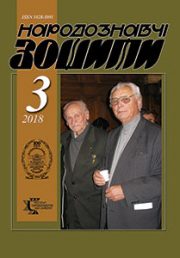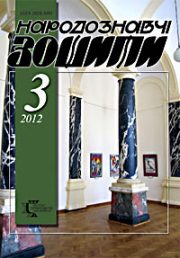The Ethnology Notebooks. 2025. № 3 (183), 613—624
UDK [392.1:393-055.62](=161.2)
DOI https://doi.org/10.15407/nz2025.03.613
HALAICHUK Volodymyr
- ORCID ID: https://orcid.org/0000-0001-7780-5876
- Doctor of Historical Sciences, Professor,
- The Ivan Franko National University of Lviv,
- Department of Ethnology,
- 1, Universytets’ka str., 79000, L’viv, Ukraine,
- Contacts: e-mail: halay_czuk@ukr.net
Abstract. The article examines the layer of folk customs, rituals, and worldviews associated with early child mortality, such as the idea of the possible impact on newborn children of the place where the mother’s dwelling is built; folk customs of passing a child through a window, symbolically «selling» it or giving it to someone else’s family for feeding; customs of taking the first person you meet or a brother and sister as godparents; the rite of making a «one-day-made» cloth; customs of giving a child a different name, calling it by the name of its parents, etc.
The relevance of the topic is explained by the relevance of studying the traditional spiritual culture of Ukrainians, including childbirth rituals as an integral part of it.
The purpose of this research is to consider and analyze the probable causes that, according to popular beliefs, could cause early child mortality, and ways to prevent it.
The object of the study is the traditional family rituals of Ukrainians, and the subject is customs and rituals designed to ensure the survival of the child in cases where previous children in the family die as infants.
The methodological basis of the article is the comprehensive involvement of a number of general scientific methods, the main of which is the method of typological analysis.
The sources of the article were materials by P. Chubynskyi, A. Onyshchuk, V. Kravchenko, N. Havrylyuk, V. Boryak, R. Siletskyi, O. Kondratovych, O. Kondratyuk, I. Hilevych, Dz. Hanus, N. Boyko and other researchers, as well as the author’s field ethnographic materials.
Keywords: ethnology, spiritual culture, folk beliefs, customs and rituals, family rituals, infant mortality, «counter» godparents, «sale» of a child, «one-day-made» cloth.
Received 8.05.2025
RЕFЕRЕNCЕS
- Chubynskyi, P. (1872). Proceedings of the ethnographic and statistical expedition to the Western Russian region, equipped by the Imperial Russian Geographical Society. Southwestern Department. Materials and research collected by a full member P.P. Chubynskyi (Vol. 1, issue 1). St. Petersburg [in Russian].
- Onyshchuk, A. (1912). From the folk life of the Hutsuls. Materials for Ukrainian ethnology (Vol. XV, pp. 90—158). Lviv: NTSh [in Ukrainian].
- Kravchenko, V. (1920). Customs in the village of Zabriddi and in some other areas not far from this village in the Zhytomyr district of Volyn. Ethnographic materials collected by Kravchenko Vasyl. Zhytomyr: Robitnyk [in Ukrainian].
- Havryliuk, N. (1981). Mapping the phenomena of spiritual culture (based on materials of Ukrainian childbirth rituals). Kyiv: Naukova dumka [in Ukrainian].
- Borysenko, V. (1997). Rites of the human life cycle. Kholmshchyna and Pidliassia: Historical and ethnographic research (Pp. 280—390). Kyiv: Rodovid [in Ukrainian].
- Boryak, O. (2018). Birth rituals. Ukraine, the state: rites of the life cycle. Encyclopedia of the history of Ukraine: Ukraine — Ukrainians (Book 1). Kyiv: Naukova dumka. Retrieved from: http://www.history.org.ua/?termin=1. 8 (last viewed: 27.04.2025) [in Ukrainian].
- Syrotkin, V. (1999). Public life. Twinning and nepotism. Ukrainians: historical and ethnographic monograph in two books (Book 1, pp. 365—370). Opishne: Publishing House of the State Museum-Reserve of Ukrainian Pottery in Opishne [in Ukrainian].
- Kondratovych, O. (2004). Protective actions of Polishchuks in the process of feeding a child. Western Polissia: history and culture. Scientific collection, 1, 160—170. Rivne [in Ukrainian].
- Kondratyuk, O. (2021). Family circle: transformation of kinship in Ukrainian society during the 19th—20th centuries. Vinnytsia: TVORY [in Ukrainian].
- Hilevych, I. (2023). Family rituals. Cultural and everyday traditions of Ukrainians of Volhynia: historical and ethnological essays (Pp. 195—245). Lviv: I. Franko National University of Lviv [in Ukrainian].
- (2016). Ethnographic image of modern Ukraine: Corpus of expeditionary folklore and ethnographic materials. Birth rituals (Vol. 3).Kyiv: M. Rylskyi Institute of Art Studies; Folkloristics and Ethnology of the National Academy of Sciences of Ukraine [in Ukrainian].
- Archives of the I. Franko Lviv National University. F. R-119. Op. 17. Op. save 150-E [in Ukrainian].
- Archives of the I. Franko Lviv National University. F. R-119. Op. 17. Od. save 179-E [in Ukrainian].
- Archives of the I. Franko Lviv National University. F. R-119. Op. 17. Od. save 193-E [in Ukrainian].
- Archives of the I. Franko Lviv National University. F. R-119. Op. 17. Od. save 200-E [in Ukrainian].
- Archives of the I. Franko Lviv National University. F. R-119. Op. 17. Od. save 203-E [in Ukrainian].
- Archives of the I. Franko Lviv National University. F. R-119. Op. 17. Od. save 244-E [in Ukrainian].
- Archives of the I. Franko Lviv National University. F. R-119. Op. 17. Od. save 320-E [in Ukrainian].
- Archives of the I. Franko Lviv National University. F. R-119. Op. 17. Od. save 323-E [in Ukrainian].
- Archives of the I. Franko Lviv National University. F. R-119. Op. 17. Od. save 330-E [in Ukrainian].
- Archives of the I. Franko Lviv National University. F. R-119. Op. 17. Od. save 331-E [in Ukrainian].
- Archives of the I. Franko Lviv National University. F. R-119. Op. 17. Od. save 713-E [in Ukrainian].
- Archives of the I. Franko National University of Lviv. F. R-119. Op. 17. Od. save 715-E [in Ukrainian].
- Archives of the I. Franko National University of Lviv. F. R-119. Op. 17. Od. save 719-E [in Ukrainian].
- Archives of the I. Franko National University of Lviv. F. R-119. Op. 17. Od. save 722-E [in Ukrainian].
- Archives of the State Scientific Center for the Protection of Cultural Heritage from Man-Made Disasters. Case V. Halaichuk-2015 [in Ukrainian].
- Archives of the State Scientific Center for the Protection of Cultural Heritage from Man-Made Disasters. Case V. Halaichuk-2016 [in Ukrainian].
- Archives of the State Scientific Center for the Protection of Cultural Heritage from Man-Made Disasters. Case V. Halaichuk-2019 [in Ukrainian].
- Halaichuk, V. (2024). When children «do not behave»: how childhood mortality was prevented in Ukraine. Local History, 11, 34—37 [in Ukrainian].
- Halaichuk, V., Harasym, L., Moisienko, V., Rachkov skyi, H., & Siletskyi, R. (Eds.). (2020). Unity in diversity. Boyky: teaching-methodical manual. Lviv; Zhytomyr [in Ukrainian].
- Nomys, M. (Ed.). (1993). Ukrainian proverbs, sayings and such. Kyiv: Lybid [in Ukrainian].
- Onyshchuk, A. (1912). Funeral customs and rites in the village Karliv, Snyatyn district. In: Hnatiuk V. Funeral customs and rites: Ethnographic collection (Vol. XXXI—XXXII, pp. 315—338). Lviv [in Ukrainian].
- Siletskyi, R. (2011). Traditional building rituals of Uk rainians. Lviv: I. Franko Lviv National University [in Ukrainian].
- Halaichuk, V. (2024). From the spiritual culture of the Hutsuls (Notes from the village Bystrets in the Verkhovyna district). Bulletin of the Lviv University. Historical Series, 56, 497—520. Lviv: I. Franko Lviv National University [in Ukrainian].
- Kolberg, O. (1890). Complete works. Cholm Land. Ethnographic image (Vol. 33, part 1). Krakiv [in Polish].
- Dobrovolski A. (1895). The people of Hrubeshiv county. Lud: Organ of the Ethnological Society in Lviv, 1, 157—167; 207—218; 244—256. Lviv [in Polish].
- Telehey, N. (2024). The one-day-made cloth: The reconstruction of the rite and the use of Cloth. Bulletin of the Lviv University. Historical Series, 56, 257—278. Lviv: I. Franko Lviv National University [in Ukrainian].
- Stef’yuk, I. The Exchanger and the Sold: Everyone Has a Secret. Retrieved from: http://bukcentre.cv.ua/index.php/tradytsiina-kultura/zvychai-ta-obriady/4586-obminnyk-i-prodan-u-kozhnoho-po-taiemnytsi.html (last viewed: 26.04.2025) [in Ukrainian].







